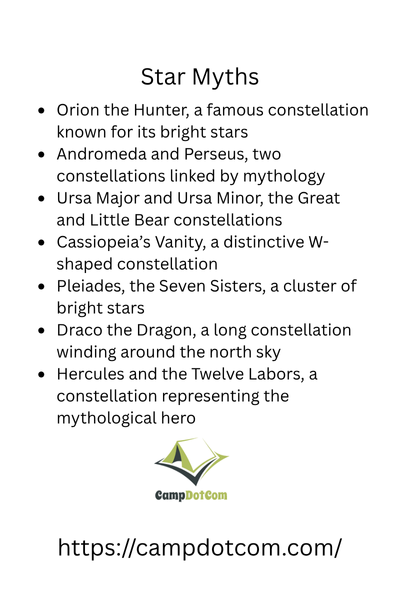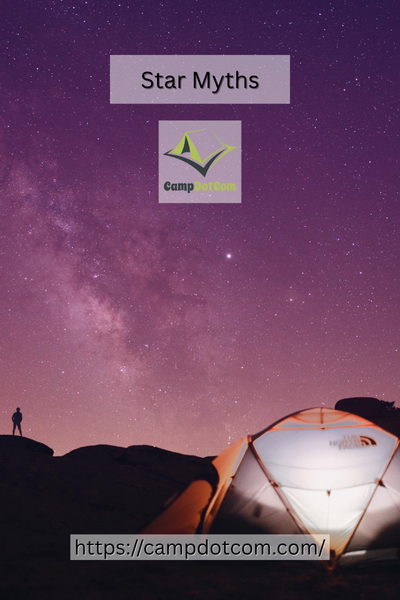If you’ve ever looked up at the night sky and wondered about the twinkling dots above, you’re not alone. I’ve always been fascinated by star myths — those wild, beautiful stories people told to explain the stars, long before telescopes and science came along.
I remember one summer night camping out in my backyard (yes, the whole sleeping bag, s’mores, and trying-not-to-freak-out-about-sounds situation). Lying there under a big, open sky, my dad pointed out constellations and shared some of the star myths he grew up hearing. I was hooked. It felt like the stars weren’t just there; they were alive with meaning and mystery.
Read More About Star Myths

What Are Star Myths, Anyway?
Star myths are the ancient stories that tie constellations and stars to gods, monsters, heroes, and even tragic love stories. Every culture had their own versions, from the Greeks’ famous tales to the Aboriginal peoples’ dreamtime legends.
As an Amazon Associate, I earn from qualifying purchases. Some of the links in this article are affiliate links. This means that, at zero cost to you, I will earn an affiliate commission if you click through the link and finalize a purchase.
More Things to Know About Star Myths

Myths about stars were not just for entertainment. They explained things people could not understand, like why the seasons changed, why certain animals acted strangely, or why life sometimes felt out of our control. And honestly, some of these stories are even more exciting than anything Hollywood could create.
Take Orion for example. You probably recognize his belt, those three bright stars in a row. According to Greek mythology, Orion was a giant huntsman placed among the stars by Zeus. But depending on who tells the story, he is a hero, a bit of a show off, or even a tragic figure. You have to love that kind of complexity.
Different Cultures, Different Star Myths
What is amazing is that star myths show up all over the world. Even cultures that never had any contact with each other created completely different but equally captivating stories about the same stars.
The Native American Lakota people saw the stars of the Big Dipper not as a dipper at all but as part of a great bear chase across the sky. Meanwhile in China, the Summer Triangle is tied to the touching story of two star crossed lovers, a weaver girl and a cowherd, separated by a river of stars, which we call the Milky Way.
It is like everyone looked at the same cosmic canvas and painted their own pictures on it. Pretty humbling when you think about it, right?
Why Star Myths Still Matter Today
You might be wondering, “Okay, cool history lesson, but why should I care about star myths now?” Trust me, I get it. But here’s the thing: these stories connect us to something bigger than ourselves.
In a world that’s always rushing, always buzzing, star myths remind you to slow down, look up, and imagine. They’re a link to our ancestors, a connection to all the dreamers and storytellers who stared at the same stars hundreds — even thousands — of years ago.
Plus, knowing a few star myths makes stargazing about a thousand times more interesting. Instead of just pointing out stars and sounding like you swallowed a science textbook, you get to say things like, “Hey, see that bright red star? That’s Antares, the heart of the scorpion in the Scorpio myth — and it’s been terrifying people for centuries!” Instant cool points, right?
My Favorite Star Myth
Honestly, I can’t talk about star myths without sharing my absolute favorite: the story of Cassiopeia. She was a queen who bragged that she and her daughter were more beautiful than the sea nymphs — and the gods did not take that well.
Long story short, Cassiopeia ends up chained to her throne and stuck in the sky forever, spinning around the North Star. Sometimes she’s upright, sometimes she’s upside-down, which feels like a cosmic reminder to stay humble — or else.
Something about the drama and the justice of it all just cracks me up. Plus, it’s kinda relatable. Who hasn’t gotten a little too full of themselves at one point, only to have the universe (or a friend, or life in general) humble you real quick?
How You Can Start Exploring Star Myths
If you’re even a little curious, I’d say grab a cozy blanket, find a dark spot away from city lights, and start stargazing. There are tons of free apps that can help you spot constellations and read about their star myths. Or you could do it old-school and pick up a book on mythology.
Honestly, even just learning two or three stories can totally change how you see the night sky. Suddenly, you’re not just looking at stars — you’re looking at gods, heroes, epic battles, and timeless love stories playing out overhead.
And who knows? Maybe you’ll even come up with your own star myth. (If you do, please tell me. I’d love to hear it.)
Star Myths Echoes of Wonder Across Time
So next time you’re outside at night, take a second to look up. Remember that those stars have been inspiring wild, funny, heartbreaking, and thrilling tales since humans first walked the earth. Star myths aren’t just dusty old stories — they’re living, breathing pieces of our shared imagination.
And honestly? In a world that can feel way too practical sometimes, keeping a little bit of that wonder alive is probably one of the smartest things you and I can do.
